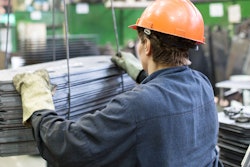SOUDAN, Minn. (AP) — Conn Mattfield was an apprentice with Lakehead Constructors when the 6,000-ton MINOS neutrino detector was built nearly a half mile below ground in the former Soudan Underground Mine.
The construction company headquartered in Superior, Wisconsin, with a branch office in Mountain Iron, built the infrastructure for the lab housing the massive U.S. Department of Energy's subatomic particle collection supermodules made up of numerous steel plates, the Mesabi Daily News (https://bit.ly/2ffSiis ) reported.
All materials used to construct the lab, the support rails and the giant detector itself — including the strips of steel that were welded together underground to form each of the 486, 12-ton, 27-foot-wide octagonal detector plates — were lowered down the shaft into the cavern on the mine's Level 27 (2,341 feet below the surface) via its small elevator cages.
Before work could even begin on the 270-foot-long, 50-foot-wide and 40-foot-high laboratory, about 50,000 tons of rock was excavated to make the underground cavity — all hauled up the elevator shaft.
It took a lot of labor and many years to construct the physics operation, which began collecting data on neutrinos in 2005.
Some 15 years after Lakehead completed its portion of work for the lab in 2001, Mattfield is spending his days back at the historic mine — this time as superintendent of one of Lakehead's latest projects: Disassembling the neutrino detector.
Everything must again be hauled in the cages operated by a hoist system capable of carrying 6-ton loads at a time.
"It's a pretty cool experience," Mattfield said of returning to the mine and having the opportunity to oversee such a one-of-a-kind job.
A whole lot of physics took place in that lab. Scientists, engineers and researchers from all over the world were involved in the Soudan experiment's study of the elusive subatomic particles that interact so rarely with other matter that trillions of them pass through our bodies each second without leaving a trace.
But with the detector's work complete — and further neutrino studies taking place elsewhere, including at the Ash River facility — it was time to deconstruct the modules and scrap the steel that played a role in helping scientists better understand one of the most mysterious of the fundamental particles that make up the universe.
Hailey Lislegard is one of the six-member crew working on the project.
A crane operator apprentice, she is responsible for maneuvering the 25-ton overhead crane used to lower to the cavern floor each of the 12-ton plates stacked vertically on the support rails.
It's an amazing project to be involved with, said Lislegard, who attended special training in operating the remote-controlled crane.
During her short time with Lakehead, she has worked a couple very distinctive projects — each at sites of former mining operations. She previously operated one of the cranes at the Highway 53 Bridge project, helping to construct what will be Minnesota's tallest bridge crossing the Rouchleau Mine Pit lake in Virginia.
Two "very cool projects ... all within a short time," Lislegard said on a recent day as she and the crew began a sort of experiment of their own — cutting for the first time one of the plates using a plasma torch tractor specially built to sever the huge one-inch-thick pieces of steel.
Most people only get to see the lab and experience the three-minute ride down the shaft in the cage while taking tours of the mine, which became the Soudan Underground Mine State Park through the Department of Natural Resources after U.S. Steel donated the property to the state in 1962 following the closure of the underground operations. About 40,000 visitors take tours each year at what is now known as the Lake Vermilion-Soudan Underground Mine State Park.
For Lislegard and fellow workers, however, traveling to the depths of the mine is a daily adventure.
And dismantling the materials that played a role in scientific discovery is some pretty cool stuff, too.
The MINOS experiment, which stands for Main Injector Neutrino Oscillation Search, probed the secrets of the subatomic particles and helped physicists study their mass.
The experiment collected data on what happens when mueon neutrinos (one of three kinds of the particle) oscillate over a distance. While neutrinos were previously thought to be massless, the presence of oscillation suggested — and through the MINOS collection data provided evidence — that they do have a small mass.
During the MINOS experiment, a particle accelerator located at Fermi National Accelerator Laboratory, a physics lab 40 miles west of Chicago, beamed neutrinos, formed through particle interactions, to the Soudan detector in bursts of 130 trillion.
Once the neutrinos reached the Soudan cavern — taking just .0025 seconds to make the 450-mile underground journey — they passed through the extremely sensitive energy detector consisting of two supermodules. Each supermodule contained 243 of the octagonal steel plates, alternated vertically with custom-built plastic scintillator strips containing fiber optic cable.
The scintillator was embedded with chemicals that produce pulses of light generated by neutrino interactions. Computers measured the energy of the particle interactions and recorded the momentum of outgoing neutrinos by tracking their paths as they passed through the magnetized steel plates.
Since so few neutrinos would actually interact with the detector — the vast majority zooming right through it and off into space — it took many years to complete research for the MINOS project.
MINOS received the last beam of neutrinos at midnight on April 30, 2012. However, a continuation of the project, MINOS+, launched in September of 2013, and the detector collected further data on neutrinos for three years.
Mattfield and his crew began the dismantling project in early October.
They used the first four plates to construct forms for cutting the remainder of the plates.
Donning shades to protect their eyes from the arc of the plasma cutters, the workers on this recent afternoon watched as the tractor made its way across Plate No. 480, slicing through the steel to create pieces small enough to fit into the cages that once carried miners to their laborious jobs underground.
Getting the pieces of steel into bundles would be the next task. And also for the first time on this day, crew members secured a heavy-duty magnet, capable of lifting 1,100 pounds, to one of the pieces.
Using the remote control to guide the overhead crane, Lislegard lifted one of the pieces off the platform. It would be her job, as well, she said, to operate the forklift to get the bundles to the elevator.
The project is set to take six months, Mattfield said. The steel — much of it mined, rolled and cut in the region during construction of the detector — will be sold for scrap, he said.
During the MINOS experiment, the University of Minnesota leased the laboratory from the state, running it under a contract from the federal Department of Energy.
While tours of the mine will continue, once the detector is removed, the lab cavern will be ready for a new tenant. Perhaps one ready to take on the next scientific breakthrough a half mile underground.
___
Information from: Mesabi Daily News, https://www.mesabitribune.com/






















